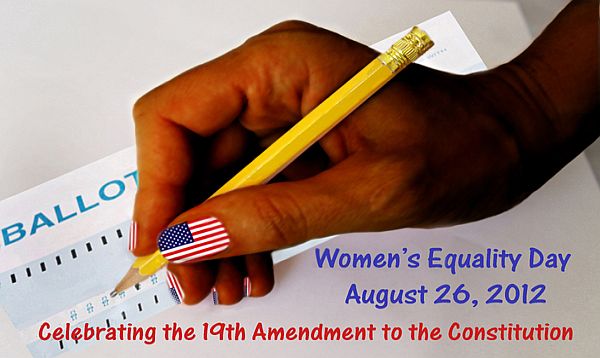Did you know that the long and difficult struggle for women's right to vote lasted 72 years? Certainly the struggle was compounded by the fact that women were not even allowed to speak at public forums in that era. Can you imagine that in this current election year?
Now, both men and women in the United States celebrate Women's Equality Day on August 26th. It was on that day in 1920 - eight days after it had been ratified - that the 19th Amendment to the U.S. Constitution was declared in effect, giving female citizens the right to vote in all U.S. elections. Sad to say, only one of the suffragists who attended the historical Woman's Rights Convention in Seneca Falls in 1848 was still alive to vote in the 1920 presidential election.
The 19th Amendment was not only a landmark for democracy in our nation's history; it was the first step on a long path towards raising consciousness about equality - equality for women of all social ranks and equality for women and men of all skin colors and religious denominations.
Let's turn to the present 2012 Presidential Election Year. Will this be an "election all about women," as the title of an April 2, 2012 article in The Atlantic suggests?
The Presidential and Vice-Presidential Nominees
It's an all male race in November with the exception of candidates chosen by the Green Party, which selected two women, presidential nominee Jill Stein and vice-presidential nominee Cheri Honkala. Women may not be running in the two largest political parties, but their votes will have a major impact on who wins. The candidates know that they will ignore them only to their own peril.
The Issues
The issues are being hotly discussed, but according to a USA Today/Gallup Swing-State Poll in April, "Men and women (among registered voters in 12 of the top swing states) show somewhat different priorities when identifying issues that are 'extremely important' in influencing their vote for president." And the closer we get to the election, the more women it seems are bringing up the issues specifically related to females.
Political Discourse Via Social Media Tools
Everyone would probably agree that social media tools have become an increasingly important means for political discourse and information sharing today. So who is using these tools? In 2011, female Facebook users in the U.S. outnumbered male Facebook users in all age categories!
Facebook reported that the 55-64 age group, which included two million more female users than male users, was almost the size of the 13-17 group, in which there were one million more females than males. An anecdotal observation is that these older female Facebook users may be just as likely to be sharing political links as they are to be sharing pictures of their grandchildren.
Most reports are also indicating that the number of females in the U.S. using Twitter is slightly higher than the number of male Twitter users.
The Presidential Debates
Largely thanks to the efforts of three teenage women, the moderators for this year's presidential and vice-presidential debates will be evenly divided between male and female journalists. When sixteen-year-olds Emma Axelrod, Elena Tsemberis and Sammi Siegel, all from Montclair, New Jersey, learned in civics class that it has been twenty years since a female journalist moderated the presidential debates, they started a Change.org petition. The 122,000 signatures they collected fell slightly short of the number needed but their campaign caused a lot of attention and in the end brought success!
Women in Congress
Little has changed since I started writing articles for Women's Equality Day in 2006, when 81 of the 535 House and Senate seats were held by women. Now women hold 90, or 16.8%, of the 535 seats in the 112th U.S. Congress - 17, or 17.0%, of the 100 seats in the Senate and 73, or 16.8%, of the 435 seats in the House of Representatives. In addition, three women serve as Delegates to the House from Guam, the Virgin Islands and Washington, DC. It is not a dramatic increase, but at least it is in the upward direction. We can all see we are not equal yet!
Voter Turnout - The Gender Factor
If the turnout of voters in the upcoming presidential election follows the trend of the past three decades, the proportion of eligible female adults who will vote will exceed the proportion of eligible males who vote. According to The Center for American Women and Politics (CAWP), Eagleton Institute of Politics, Rutgers University, 70.4 million women and 60.7 million men voted in the 2008 Presidential Election. Even among citizens between the ages of 18 - 24, the percentage of women voting was higher than that of their male peers.
Taking these hard facts into account, you can see that a woman will very likely cast the deciding vote on November 6.
I close with this message: May Women's Equality Day be a reminder to ALL of us to express our precious right to vote! Remember this isn't just a presidential election; it's a general election, so lots of seats for Congress will be decided too. Look up your candidates, see where they stand on the issues, make your choice, and vote on November 6, 2012 - whether you live at home or abroad!
Some Helpful Voter Resources:
• Non-partisan information on elected officials' voting records and candidates' positions: Project Vote Smart
• Non-partisan information about Congress including more demographic information: Congress.org
• A non-partisan organization providing online tools and services for U.S. voters living abroad: Overseas Vote Foundation and their website for young voters Youth Vote Overseas - both provide a handy Candidate Finder
• A non-partisan organization that provides young women and girls with the skills and confidence they need to become the political leaders of tomorrow: Running Start


